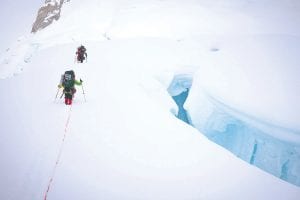With predictions of a fierce winter storm blowing in, and less than two days from the summit, Lonnie Dupre and his three climbing partners made the decision to give up their quest to scale Mount Hunter—or Begguya as the indigenous people call it—and head back to basecamp.
The decision came after the four climbers had spent two long days climbing 3,800 vertical feet with heavy backpacks. They set up their last camp at 10,300 feet on the knife-edge ridge of the mountain.
“It was a spectacular view,” said Dupre of looking up at the jagged 14,000-foot summit.
A view to almost die for.
“Between that ridge and our tent, I fell into a large crevasse 20 feet from camp, catching myself on the lip with my upper body,” said Dupre.
Casting a wary eye for the oncoming storm and in fear of avalanches, the crew spent a long day climbing down to their basecamp on May 1.
Following the aborted attempt, Dupre said his fellow climbers Willi Prittie, Pascala Marceau, and Chris Worlow were fine, albeit sore and tired.
Will he try again?
“Hunter will be there for another attempt,” said Dupre.
Due to its steep vertical, less than 40 percent of those attempting to climb Mount Hunter (Begguya)—succeed.
Dupre used this climb to test new gear—from backpacks to boots—as a training ground for his planned attempt in the fall to scale one of the unclimbed mountains in the Himalayas. With more than 25 years of cold weather Arctic exploration behind him, Dupre is one of the preeminent Arctic explorers of the last century. He can be followed on his One World Endeavors website.



Loading Comments